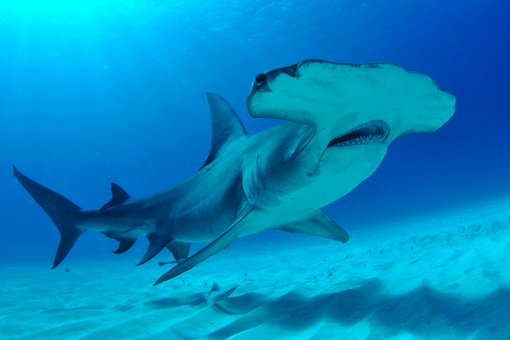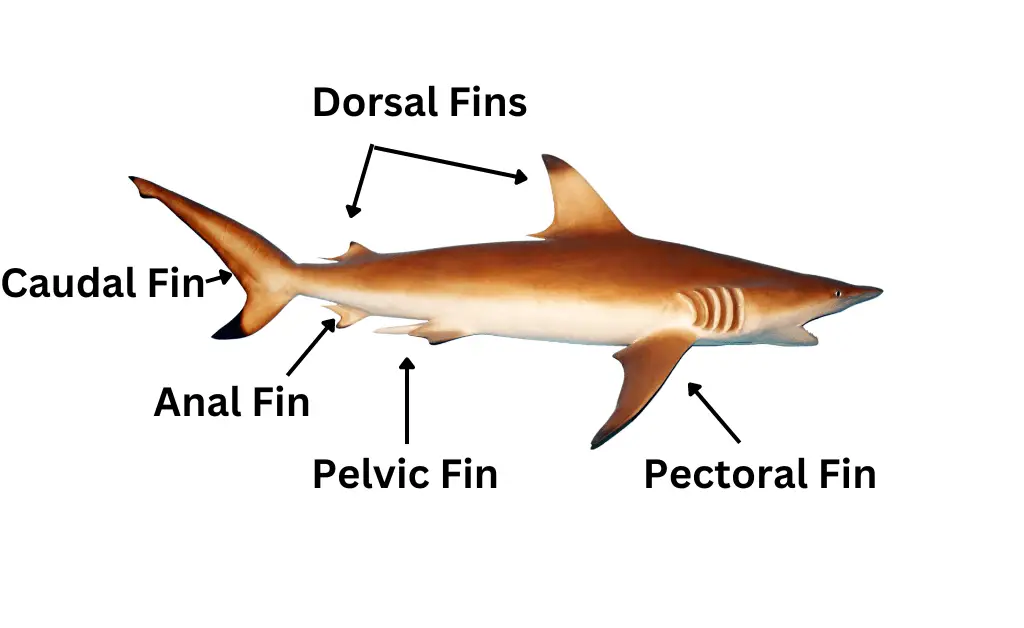Ever run into a trivia question regarding sharks? One that often trips people up is whether a shark is considered a mammal or a fish. From the great white to the hammerhead, sharks are one of the most exciting species in the water around the world.

Read on to find the answer to the question “Are Sharks Mammals or Fish?” including the reasons behind this classification. Learn all about this misunderstood ocean-dweller in the guide below.
What Is a Mammal?
A mammal is a biological classification characterized primarily by the presence of mammary glands (which females use to feed their babies), a neocortex region in the brain, three middle ear bones, and typically either fur or hair. In addition, mammals are a group of vertebrate animals instead of invertebrate animals.
What Is the Difference Between Mammals and Fish?
There are many differences between mammals and fish. The primary differences are:
- Mammals are warm-blooded, and fish are cold-blooded
- Mammals typically move using limbs, while fish use fins to move
- Mammals breathe air through a lung system, while fish use a gill system to breathe
- Mammals have a neocortex, and fish do not have a neocortex region in the brain
- Mammals give birth to live young, and fish generally lay eggs
Are Sharks Mammals or Fish?
Sharks are fish, not mammals. There are many marine mammals, including dolphins and whales, but sharks are not a part of this group. Below are some distinguishing factors that make a shark a mammal, not a fish.

Aquatic Mammals vs. Fish Breathing Mechanisms
Aquatic mammals breathe the same way humans do, using a respiratory system that features lungs. No, these animals haven’t managed to learn how to breathe underwater. Instead, they’ve actually learned how to hold their breath for an incredibly long time. Many aquatic mammals can hold their breath for as long as an hour, but they all eventually surface to breathe air.
In opposition, fish use their gills to absorb oxygen underwater. Gills are an organ located on either side of a fish’s head. The gills contain small blood vessels which absorb oxygen from water that flows over it.
Marine Mammal Skin vs. Fish Skin
Marine mammals have an integumentary system, like humans, consisting of three distinct layers of skin. These mammals have an outer layer called the epidermis, a middle layer called the dermis, and an inner layer called the hypodermis. The hypodermis in marine mammals is far thicker than in other mammals because it provides insulation.
Fish have scales as the outermost layer of their body. Scales are an assortment of layered rigid plates. The scale material is similar to the material that creates teeth in humans and other animals.
Marine Mammal Dorsal Fin vs. Fish Dorsal Fin
A dorsal fin is a central fin located on the middle back of a fish or mammal. Both marine mammals and fish have dorsal fins. Not all marine mammals and fish have dorsal fins, but the vast majority of species have at least one dorsal fin. The fin serves a similar purpose for both groups, helping center the animal and keep them from losing balance.
However, in marine mammals, the dorsal fin helps regulate the mammal’s body temperature, which is not a function present in the dorsal fins of fish. Mammals are warm-blooded, but fish are cold-blooded, so it makes sense why only one group would require this function.

Additional Reasons Why Sharks Are Not Mammals
While the primary reasons sharks aren’t mammals are listed above, a few additional aspects distinguish sharks from mammals. Here are some of the other mammal characteristics that sharks lack.
Sharks Lack a Mammary Gland
One of the primary characteristics that mark a mammal is the presence of a mammary gland that produces milk, which the female can use to feed their young. Sharks do not have a mammary gland, but their reproductive cycle does vary from other fish species.
Most fish lay hundreds or even thousands of poorly-developed eggs, meaning a small fraction of the eggs will grow to become viable young. In contrast, sharks lay a lower number of well-developed eggs, so a greater fraction of the eggs are viable.
In addition, unlike most fish, sharks have a slow maturation cycle, which also feeds into a long life expectancy for a fish, around twenty to thirty years on average.
Sharks Are Not Warm-Blooded Animals
Mammals are warm-blooded animals, and fish, like sharks, are cold-blooded animals. Warm-blooded animals maintain an internal body temperature independent of the environment around them. Therefore, the internal body temperature is generally high in warm-blooded animals.
Cold-blooded animals have an internal body temperature that adapts and mimics their surrounding environment. For example, a cold-blooded animal will take on a low internal body temperature in a cold environment. In contrast, the same animal in a hot environment will have a high internal body temperature.
Sharks Lack an Inner Ear Bone
In mammals, there are three small bones in the inner ear. Collectively, these three bones are known as the ossicles. Individually, they are the malleus, incus, and stapes. These bones help carry sound from the eardrum so the inner ear and brain can process it.
In contrast, sharks have a direct channel from the outer ear to the inner ear, which carries sound. Sharks don’t have bones, so there are no other routes through the ear for sound.
Sharks Do Not Have a Neocortex
The neocortex is one of the defining features of mammals. In the brain, the neocortex facilitates higher cognitive function, which helps with concepts like episodic memory, thought, attention, and perception. The neocortex makes up over half of the brain’s total volume in humans.
Because fish, like sharks, do not have a neocortex, we know they don’t experience emotions or feelings in the way we think of them.
What Makes Sharks a Fish?
We’ve covered why a shark is not a mammal, but what are the reasons a shark is classified as a fish? Here are some of the key elements that make a shark a fish.
Shark Anatomy Features Multiple Dorsal Fins
Sharks have two dorsal fins, which stand in contrast to marine mammals. Marine mammals generally only have one dorsal fin, though in some cases, like the narwhal, some marine mammals have no dorsal fin at all.
In marine mammals, the dorsal fin helps regulate body temperature, but a shark’s two dorsal fins are connected by cartilaginous rods and help the fish balance in the water. The first dorsal fin is much larger, and the second dorsal fin acts as a secondary stabilization feature.
Shark Anatomy Includes a Vertical Tail Orientation
Sharks have a vertical tail orientation, meaning they move their tails from left to right to move. Marine mammals have a horizontal tail orientation, meaning they move their tails up and down to move. This vertical tail orientation helps sharks move incredibly fast in the water.
Different types of sharks have different tail features as they have evolved. For example, whale sharks have a crescent-shaped tail that helps with their speed.
Shark Anatomy Features a Short Intestine
Mammals, including aquatic animals like whales and dolphins, generally have long intestines which take the form of a tube. Most mammals have a small and large intestine, two individual sections of the digestive system.
However, shark intestines do not resemble a long tube and are more similar to a spiral. The shape is similar to a corkscrew, and digested food makes its way through short turns. The digestive system of marine mammals like dolphins is far more similar to the intestine of a human than to a shark.
What Type of Fish Is a Shark?
A shark is an example of a cartilaginous fish, meaning the skeleton of the fish is made of cartilage instead of bone. The other possible category of fish is Osteichthyes, commonly called bony fish, which is the better-known category when you first think of “fish.” Examples of bony fish are carp, catfish, salmon, and trout.
Along with sharks, other examples of cartilaginous fish include rays and skates.
Why Do Sharks Get Mistaken for Mammals?
Sharks are often mistaken for mammals because they are large, and their scales aren’t extremely apparent. When looking at aquatic animals, any person would likely compare a shark to a dolphin or whale rather than bass or other small fish.
Because people think of sharks in the same category as whales and dolphins, which are both examples of marine mammals, many assume that sharks are also in the mammal category.
Final Thoughts
So, are sharks mammals or fish? Sharks are one of the mysterious and misunderstood underwater animals that anyone would benefit from learning more about. Luckily, there has been a recent push for everyone to learn more about these animals, especially as population numbers have waned over the years.
It’s surprising to many that sharks are, in fact, fish and not a mammal, but when you look at the facts, it’s quite apparent that sharks are solidly under the classification of fish.
- Do You Need An Indicator For Nymph Fishing? - November 16, 2023
- Fishing Safety Tips For Families - September 25, 2023
- What Is The Best Time To Night Fish At A Lake? - September 18, 2023









